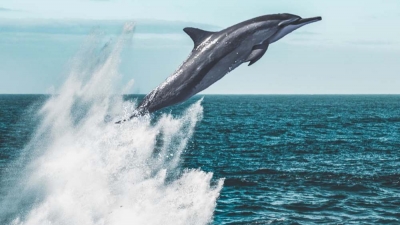
Odisha Forest Department officials, wildlife experts and researchers carried out the 2020 dolphin census in the State’s aquatic ecosystems, including the Chilika lake, the Rushikulya river and off the Gahirmatha coast. Though Chilika recorded 146 Irrawaddy dolphins, a spike from 130 in 2019, the overall count of dolphins in Odisha’s waters was at 233 dolphins, down from 259 in 2019 and 469 in 2018. The consistent drop was also observed at Gahirmatha, where the population has almost halved from last year. Forest officials spotted only 62 dolphins during the census. In 2019, it was 126 and in 2018, 307! The dolphin species sighted during the State-wide census include the Irrawaddy, the bottle nose and the humpback.
India is also home to the iconic Ganges (or Gangetic) river dolphin, which is also the National aquatic animal. But this honour has not given the species an advantage over fellow dolphin species , when it comes to survival. Ganges river dolphins once lived in the Ganges-Brahmaputra-Meghna and Karnaphuli-Sangu river systems of Nepal, India and Bangladesh. But the species is disappearing from most of its distribution ranges. These dolphins are one of the three surviving freshwater dolphin species in the world. The other two are found in the Indus in Pakistan and the Amazon in South America. A fourth species, the Yangtze river dolphin in China, has gone extinct.
Gangetic river dolphins are categorised under Schedule I of the Indian Wildlife (Protection) Act and have been placed on the red list of the International Union for Conservation of Nature (IUCN), which signifies that the species is on the verge of extinction.
So, why is the dolphin population declining?
ABOUT DOLPHINS
- Dolphins are aquatic mammals within the infraorder Cetacea, which also includes whales and porpoise.
- Dolphins are recognised by their set of small teeth and curved or beaked mouths, putting an eternal smile on their face. They have streamlined bodies and two limbs that are modified into flippers. They have a layer of fat, or blubber, under the skin to keep them warm in cold water.
- Most dolphins live in the ocean or brackish waters along coastlines, but there are a few such as the Ganges river dolphin that live in freshwater streams and rivers.
- Dolphins feed largely on fish and squid, but a few, such as the killer whale, feed on large mammals such as seals.
- Dolphins are highly social creatures, living in pods. They communicate with squeaks, whistles and clicks.
- Bottlenose dolphins have been found to have signature whistles, with each individual having a unique sound.
- Dolphins help each other in times of distress. They have also been seen helping other species. They have been spotted helping fishermen by leading them to a school of fish to catch. They have been seen protecting swimmers from sharks by swimming around them or preventing sharks from getting closer to the swimmers.
- Generally, dolphins sleep with only one brain hemisphere shut at a time, thus maintaining enough consciousness to breathe and to watch for possible predators and other threats using the other.
ECHOLOCATION
Just like bats, dolphins (whales and porpoises) use echolocation to navigate through the dark, murky waters. Echolocation allows dolphins to “see” by interpreting the echoes of sound waves that bounce off objects near them in the water.
To echolocate, dolphins produce high-frequency clicks. These clicks create sound waves that travel quickly through the water around them. Dolphins and whales use this method to sense an object’s distance, direction, speed, density and size. Using echolocation, dolphins can also differentiate between species.
They also use echolocation to communicate.
INTELLIGENCE
Since there is no concrete definition of intelligence, scientists refuse to take a firm stand on the dolphins’ intelligence. They engage in creative play, show empathy towards member of their species and other species, use tools, pass knowledge on to next generation, mourn the death of a fellow dolphin, and collaborate with each other within a pod to complete a task. Their form of communication is diverse and evolving. Through experiments, scientists have shown that dolphins have an excellent learning ability. They respond to images on television and imitate the actions of human beings.
GANGES RIVER DOLPHINS:
- Gangetic river dolphins live in shallow, often narrow, stretches of the rivers.
- They have long, pointed noses, prominent teeth and a brownish, stocky body.
- Gangetic river dolphins are effectively blind. They depend on echolocation to navigate, play, find food, mate and flee from danger. They produce ultrasonic or high-frequency clicks in the 20- to 160-kilohertz range.
- Ganges river dolphins are the top predators in their river ecosystems. They are important in controlling and maintaining healthy fish and crustacean populations, their primary sources of food. Unfortunately, these river dolphins are facing the adverse effects of human impact.
THREATS TO DOLPHINS
- In the marine ecosystem, dolphins have few enemies. For smaller species of dolphins, the larger sharks are potential threats.
- Dolphins also suffer from a wide variety of diseases and parasites.
- Their main threat comes from being caught accidentally in commercial fishing nets. Entanglement prevents dolphins from rising to the surface to breathe, which eventually kills them.
- As dolphins use echolocation for most of their activities, noise pollution from ships disorient them. It also affects their brain, causing internal bleeding, studies suggest.
- For freshwater dolphins, threats come in the form of pollution – caused by pesticide run off and discharge of industrial and municipal waste. Injuries or deaths due to collisions with boats, entanglement in fishing gear, degradation of habitat, poaching and global warming are some of other threats.
Picture Credit : Google




